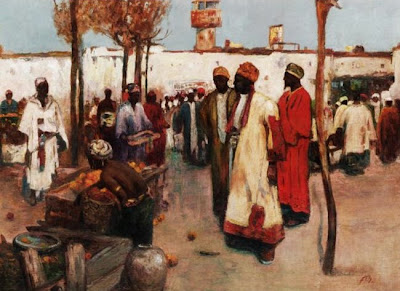

During the early 19th century, North Africa and the Middle East were opened to French tourism, thanks to the imperialist exploits of Napoleon on his quest for empire. Amongst these intrepid explorers was an artist, Paul Lenoir.
Monsieur Lenoir wrote a book,
The Fayoum; or, Artists in Egypt, about one such trip headed by his master Jean-Léon Gérôme. The objective of the journey being to collect picture material. The largely French genre of Orientalism was then the rage in Paris. One of the more popular subjects for pictures was the Almeh or l'almée* a.k.a. ghaziya**, native dancing girls. Note the enthusiasm for the subject by Austrian painter Leopold Carl Müller, who on the 27th of February 1881,was given an audience with Crown Prince Rudolf of Austria (1821-1889) in Girga, a bustling Upper Egyptian town midway between Cairo and Luxor. After dining together, the two men were treated to some local entertainment. Müller's letter to his friend and fellow painter August von Pettenkofen (1821-1889), written early the next day, has little to say about the event, but the words are intriguing, nevertheless: ". . . und am Abende haben wir egyptische Tänzerinnen angesehen. Nehme Dir an Gérôme ein Beispiel! Höchst neugierig bin ich, was Gérôme hier Neures gemacht haben wird." ["...and in the evening we saw Egyptian dancers. [I should] use Gérôme for an example! I am so curious to know what Gérôme would do if he were here."] (letter no. 309, Zemen, 2001, p. 400).


An account related by Lenoir, "I took out of my pocket one of those little neckties, price sixpence, which are much favoured by our peasants in their Sunday dress; and began by first letting Hasne see it. She jumped at it exactly like a monkey, seized it, tied it round her neck, snatched it off and tied it round her head, and then endeavoured to run away, under the impression that I was about to deprive her of the treasure. I made her understand that I gave it to her as bakshish, and then her joy was unbounded; she approached me with convulsive movements of satisfaction which resembled epilepsy. It was a triumph, but I was afraid she would bite me. A storm of words, one more sharp and discordant than the other, whistled about my ears, and our dragoman vainly endeavoured to translate the wild and oriental expressions of her savage gratitude." pg97

* An almeh, from the Arabic analeim, refers to a learned woman, high in status and educated in the musical and literary arts; European travelers mistakenly applied this term to any female entertainer. By 1850, it came to be associated most closely with the ghawazee, or Egyptian dancing girls who were often also prostitutes.
** ghawazee (singular ghaziya), or Egyptian female dancers; In 1834, in an effort to "improve" the moral fiber of the city, the Egyptian Pasha Muhammad 'Ali had banned the ghawazee from Cairo; they were ordered to the Upper Egyptian towns of Qena, Esna, and Aswan. Though this ban was lifted in 1866, travelers still made a point of visiting these notorious locations, in order to witness the most uninhibited versions of the ghawazee's performances. Not for the pleasure of European men alone, however, the ghawazee were also known to entertain local audiences: "The Ghawázee perform, unveiled, in the public streets, even to amuse the rabble" (Edward William Lane, An Account of the Manners and Customs of the Modern Egyptians, London, 1860, p. 377).
One hundred years later the imagery was still popular.












